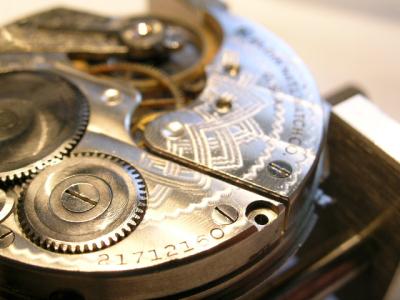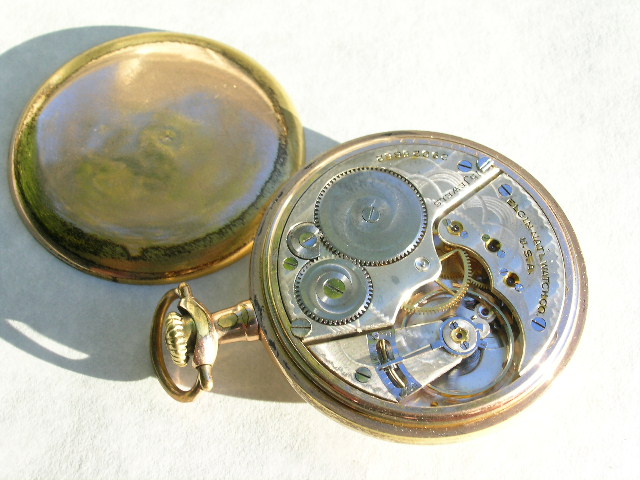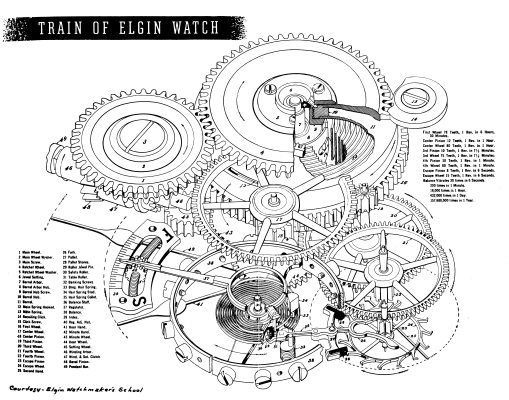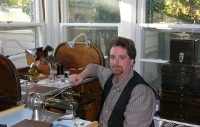|

What is Watch Cleaning?
Mechanical watch service is traditionally referred to
as "watch cleaning". Watch cleaning includes:
- Complete disassembly and individual cleaning of all parts.
- Inspection for damaged parts including worn or broken pivots,
cracked jewels and bent or missing teeth.
- Replacement of any and all parts found worn, damaged or otherwise
unusable, including proper rebuilding of balance assemblies, other
staffs, springs, wheels and jewels.
- Cleaning, adjusting and re-seating of jewels as needed.
- Removal, cleaning and rewinding, or replacement, of the mainspring.
- Other procedures such as hairspring adjustment,
setting to beat, pivot polishing, etc. as needed.
- Reassembly and proper lubrication.
- Rudimentary timing.
Unfortunately, there seem to be services available that "clean" a
watch by simply removing the entire movement from the case,
running it as-is through an ultra-sonic cleaning machine, and
replacing it in the case. In doing this, dirt will tend to
just settle back into the watch, usually in a much worse place.
This method is also unlikely to completely remove old oil.
Proper watch cleaning always involves complete disassembly.

|
|
|
I use proper and period techniques and materials throughout the work.
All the tools, procedures and materials I use in the restoration of
watches are consistent with the original recommendations of the
Elgin National Watch Co. I have taken
care to learn and apply professional, but frequently old-fashioned,
methods - no shortcuts, no substandard materials.
I learned to do this work from my
Grandfather,
Everett Sexton,
who attended the Elgin watchmakers college in the early 1930s.
He had a long career as a watchmaker of some reputation. He
never lost his fondness for Elgin products. At school,
Everett Sexton was recognized for unusual skills and was
personally instructed by William Samelius. I am very fortunate
for this. And although I've read a lot of books on watchmaking,
and I can say that much of what I learned from my Grandfather, you
won't find in a book.
If you have more questions that are not addressed on this page,
I have a repair FAQ,
here with more information.
|

A typical 16 size, 7 jewel Elgin, grade 290, made in 1918
|
|
|

Elgin Movement Serial Numbers
|
Want to find out more about your Elgin watch?
You can learn quite a bit from the serial
number of the watch works, or movement, inside.
Check here
for information on how to open a pocketwatch case, to access the
movement number. Look
here for an online database of Elgin watch production history.
Be sure to use the number of the watch movement.
Numbers on any part of the watch case, such as a serial number
on the inside of the back cover, is a number that goes with the
watch case only, and reveals nothing about the watch movement.
Elgin did not make pocketwatch cases. The watches were sold as
bare movements only. Customers selected their watch cases
separately at the retail shop, so the important number is
inside on the mechanical part of the watch.
|
|
 More About Elgin Watches
More About Elgin Watches
- The history of the Elgin National Watch Company and other information
|

Post-1960s Watches
I receive a fair number of inquiries regarding the repair of newer
Elgin watches, including quartz movements. Sadly, the
Elgin National Watch Co. went out of business in 1968, and in fact
never made quartz watches. It's the antique Elgin products, and
other early American brands, that I work with. Watches are produced
to this day under the Elgin name. These watches, many of quite
good quality, have been made over the years by a variety of Asian
and European brands, but are not products of the original Elgin
company, and so are not watches I can help with.
If you would like to locate a good watchmaker in your area, visit
the the website of the American
Watchmakers-Clockmakers Institute. On the
AWCI home page, you'll see a link for finding a watchmaker near you.
|
|
|
Cases
I typically do not do more than a surface cleaning of cases,
to remove dirt and dust that could damage the movement. It
is my personal preference to retain the character of old
pocketwatch cases where possible. Of course I do replace bows,
crowns, stems as needed, and crystals where I happen to have a
one suitable. However the movement
itself (including the dial and hands) is what interests me the most.
|
|
|
Dial Refinishing
I do not do dial refinishing. However, in the case of white
enamel dials, as most antiques have, a certain degree of repair is
practical and I do these from time to time. Every instance is
different. In most cases, the dial is best left as part of
the character of the piece, flaws and all.

|
|
|

A typical 16 size, 15 jewel Elgin, grade 313, made in 1926
|
|
A Word About Antique Mechanical Watches and Pocketwatches
in General
Antique pocketwatches are objects of great beauty and
significance. They occupy a special place in the history
of human technology, the understanding of time, mechanics and of
industrial development, particularly in America.
Luckily, many antique pocketwatches are relatively common and
affordable, which makes collecting pocketwatches an
accessible and rewarding hobby.
Even today, many antique watches, properly cared
for, can provide decades of faithful service. However
if you are interested in buying an antique watch, and
you are not already a collector, there are a few things to
keep in mind. An antique pocketwatch is not at all like
a modern quartz movement.
- Antique watches are fully mechanical devices.
They are very easily damaged by physical shocks.
- Antique watches are not remotely water resistant, and are subject
to damage due to temperature, salt air, even tiny amounts of dust,
moisture and other environmental factors.
- An antique pocketwatch in daily use requires regular
maintenance, by a skilled watchmaker, to function
correctly overtime. While these watches were once used everyday,
but they typically received a complete overhaul every year.
- Antique pocketwatches are not accurate by today's
standards. A very good watch, cleaned and adjusted
with care, can achieve an accuracy of +/- a
minute or so per 24 hours. More accuracy than this will usually
require significant efforts.
- Always store an antique timepiece in a dry and dust-free
environment. Plastic bags are not recommended as they
trap moisture and condensation.
- To learn more about watchmaking, visit the website of
the American
Watchmakers-Clockmakers Institute
Want more details about getting your watch repaired? I have a repair FAQ,
here.
|
|
|
Follow along on Google+ 
|

The working components of a typical Elgin watch
|
|
|
|
|
|
|
|
|

|
 A virtual Watch Museum
A virtual Watch Museum
-
 Jeff's Watch Blog
Jeff's Watch Blog
-
 More About Elgin Watches
More About Elgin Watches
- The history of the Elgin National Watch Company and other information
 Elgin watch mini-FAQ
Elgin watch mini-FAQ
- Frequently asked questions
 Pocketwatches For Sale!
Pocketwatches For Sale!
- Check the Elgin Time
online marketplace for various items.
Feel free to contact me, jsexton@elgintime.com, for
information on other watches that may be available, if you are looking for
something specific, or just have questions about vintage watches.
|
|







